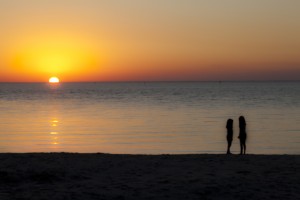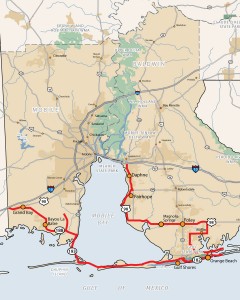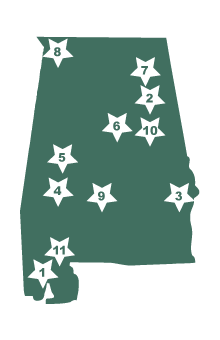“Alabama’s southern tip is one of those places where even first-time visitors find a connection. Here, they experience the link between the traditions of the Deep South and a more laid back island lifestyle; between the wildlife of thousands of acres of preserved lands and the good life of a beachfront vacation; between the gun ships of past naval battles and the countless recreational opportunities of the present and the dedication to con  servation methods for the future.
servation methods for the future.
Learn more about the Coastal Connection on their website: alabamascoastalconnection.com
Visitors make their own connections, too. Poking their toe into the sun-warmed Gulf of Mexico, they feel it. Wandering the halls of a 150-year-old brick fort and imagining the voices of soldiers who inhabited it, they understand it. Standing motionless among the trees to catch a glimpse of a colorful neo-tropical migrant bird, they recognize it. Choosing a charter captain or a seafood retailer because they’ve ‘been around these parts forever,’ they’ve made the connection.
Alabama’s Coastal Connection is a treasure to those who have discovered it and a unique asset to the state. The waters of Alabama’s Gulf Coast create its strongest connections. Some people are drawn here by the water. Others are held by it. While the natural, recreational and scenic values of the Gulf, bays, lagoons and bayous cannot be disputed, it is their cultural value that started it all. Making a living from the waters is a tradition that is alive and well here. Shell mounds hold the stories of early inhabitants who lived off the bountiful waters. Shrimp and charter boats are captained by those who still make their living that way. And research vessels carry those dedicated to understanding the waters and preserving the ecosystems that are so dependent upon them.
Historic Forts Gaines and Morgan stand united around the mouth of Mobile Bay. In earlier times they stood guard against enemies and housed soldiers prepared for battle. Today, the brick and wooden fortresses tell the stories of those battles and those soldiers to the many visitors who step onto their grounds. Further east in Orange Beach, more history can be found at the Indian and Sea Museum which chronicles the lives and ways of natives and early settlers. In Foley, the original character of the town built by those whose livelihoods were as much related to land as to the sea can still be seen in the preserved buildings and museums.
The Dauphin Island Audubon Sanctuary, Bon Secour National Wildlife Refuge and Gulf State Park provide more than12,000 acres of protected lands along the coast. Weeks Bay National Estuarine Research Reserve is one of only 25 such reserves nationally and is literally where the soil meets the sea. These vast natural assets are complimented by smaller municipal parks and trails and by the sites along the Alabama Coastal Birding Trail. Indigenous wildlife and seasonal migratory birds are common sites as are varieties of native foliage. Bon Secour Wildlife Refuge alone boasts habitats including beaches and sand dunes, salt and freshwater marshes, scrub forests, fresh water swamps and uplands. Volunteer opportunities and interpretive exhibits at these sites, as well as at the Estuarium on Dauphin Island, are excellent ways for visitors to make a connection and to get involved in good stewardship of our natural resources. (see the Coastal Birding Trail website for 50 sites, many along the byway, where you can find amazing wildlife, including birds!)
The natural beauty of these and other assets on Alabama’s Gulf Coast provide the setting for those who enjoy its scenic aspects, as well as its recreational ones. While enjoying a stroll along the shore at sunset or a quiet sail on the back waters suits some, others may opt for more exciting recreational opportunities. Golf and offshore fishing are popular pastimes. And here, dining is definitely recreation! Seafood is standard fare and can be prepared any way imaginable. A variety of accommodations are available, making the shore accessible to those looking for a campsite, a family-friendly beach house, a luxury hotel or anything in between.
More than six million visitors come to Alabama’s Gulf Coast each year, and they come back again and again. Some return to enjoy different activities at different times of year. – Special events offer a wide range of experiences. Music festivals, historic re-enactments, sporting events and celebrations of seafood are just a few. – Others return to the same spot, year after year, starting their own traditions here. Strengthening their connection to this paradise found.
Whether they are families on the annual vacation, couples seeking a secluded getaway, birders searching for that rare sighting, or history buffs combing the forts, they’ll find a connection here. And some will build their own. Alabama’s Coastal Connection has much to share and it beckons travelers to learn more about The Waters, Ways and Wildlife of Alabama’s Gulf Coast.
This highway, and the waterways that connect it, are significant to the state of Alabama for many reasons: National Historic Landmarks of Fort Morgan and Fort Gaines. The protected lands of the Dauphin Island Audubon Sanctuary, Bon Secour National Wildlife Refuge, Weeks Bay National Estuarine Research Reserve and Gulf State Park. Beaches that are the number one tourist destination in the state. A unique coastal culture. Numerous recreational opportunities.
The Byway’s storyhas several chapters: Connecting with Nature, Connecting with the Past, Connecting the Land and Sea, and Connecting with Each Other. Through these stories and through the preservation, improvement and promotional opportunities this designation affords, more people can learn of Alabama’s Coastal Connection and of The Waters, Ways and Wildlife of Alabama’s Gulf Coast, ensuring the region’s continued connection to the future.”
Learn more about Alabama’s Coastal Connection on their website (includes videos, calendar of events, and interactive map, photos and more)




